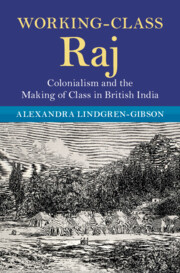Book contents
- Working-Class Raj
- Modern British Histories
- Working-Class Raj
- Copyright page
- Contents
- Acknowledgments
- Introduction
- 1 Family Histories and Remaking Class in British India
- 2 Writing Family Together across Imperial Distances
- 3 Military Domesticity
- 4 Servants in Empire
- 5 Class and Colonial Knowledge
- 6 Fragmented Families
- Bibliography
- Index
Introduction
Published online by Cambridge University Press: 20 October 2023
- Working-Class Raj
- Modern British Histories
- Working-Class Raj
- Copyright page
- Contents
- Acknowledgments
- Introduction
- 1 Family Histories and Remaking Class in British India
- 2 Writing Family Together across Imperial Distances
- 3 Military Domesticity
- 4 Servants in Empire
- 5 Class and Colonial Knowledge
- 6 Fragmented Families
- Bibliography
- Index
Summary
This book begins with a family that does not fit. Pollie Keen was born to a Buckinghamshire washerwoman. She spent her teenage years as a servant, married a farm laborer-turned-soldier, and lived out her late twenties as a lady of leisure, flitting between tea parties, carriage rides, and dances that lasted into the early hours of the morning. In 1889, Pollie, her three children, and her husband Dick, by then a sergeant with the Royal Horse Artillery, went to India. It was once the family had settled in Sialkot in Punjab that Pollie’s social status and material world changed so dramatically. Dick wrote to his brother that the family was enjoying the “fine country” and enumerated the servants at their disposal. “I am same [sic] like gentleman. We are both in bed when the cook comes in to light the fire, lay the breakfast and all ready before we get up, and the barber taps at the door to shave me and man is waiting to clean the boots and clothes for all of us.”1 Having fires laid, shoes polished, breakfast made, and a barber at the ready were luxuries Dick and Pollie could never reasonably have hoped for in Britain. Pollie bragged to her mother that, after a lifetime of domestic labor, her only duties were dusting and changing the bed linens.2
- Type
- Chapter
- Information
- Working-Class RajColonialism and the Making of Class in British India, pp. 1 - 23Publisher: Cambridge University PressPrint publication year: 2023



